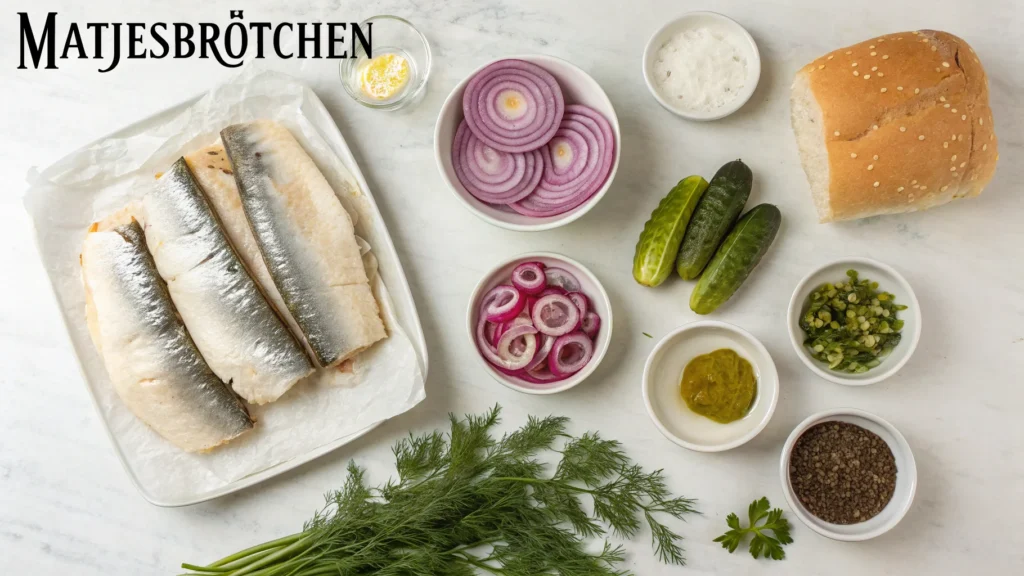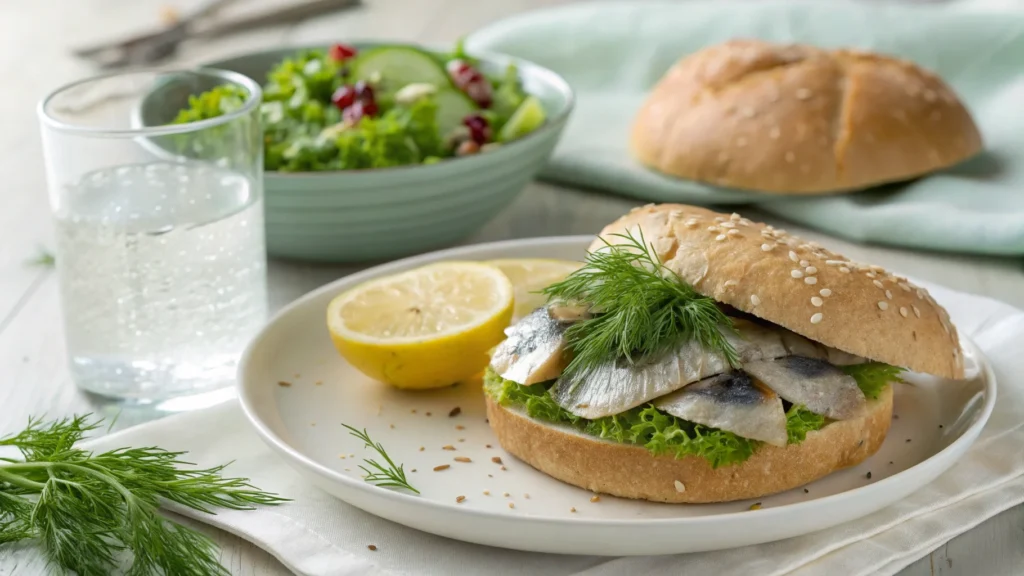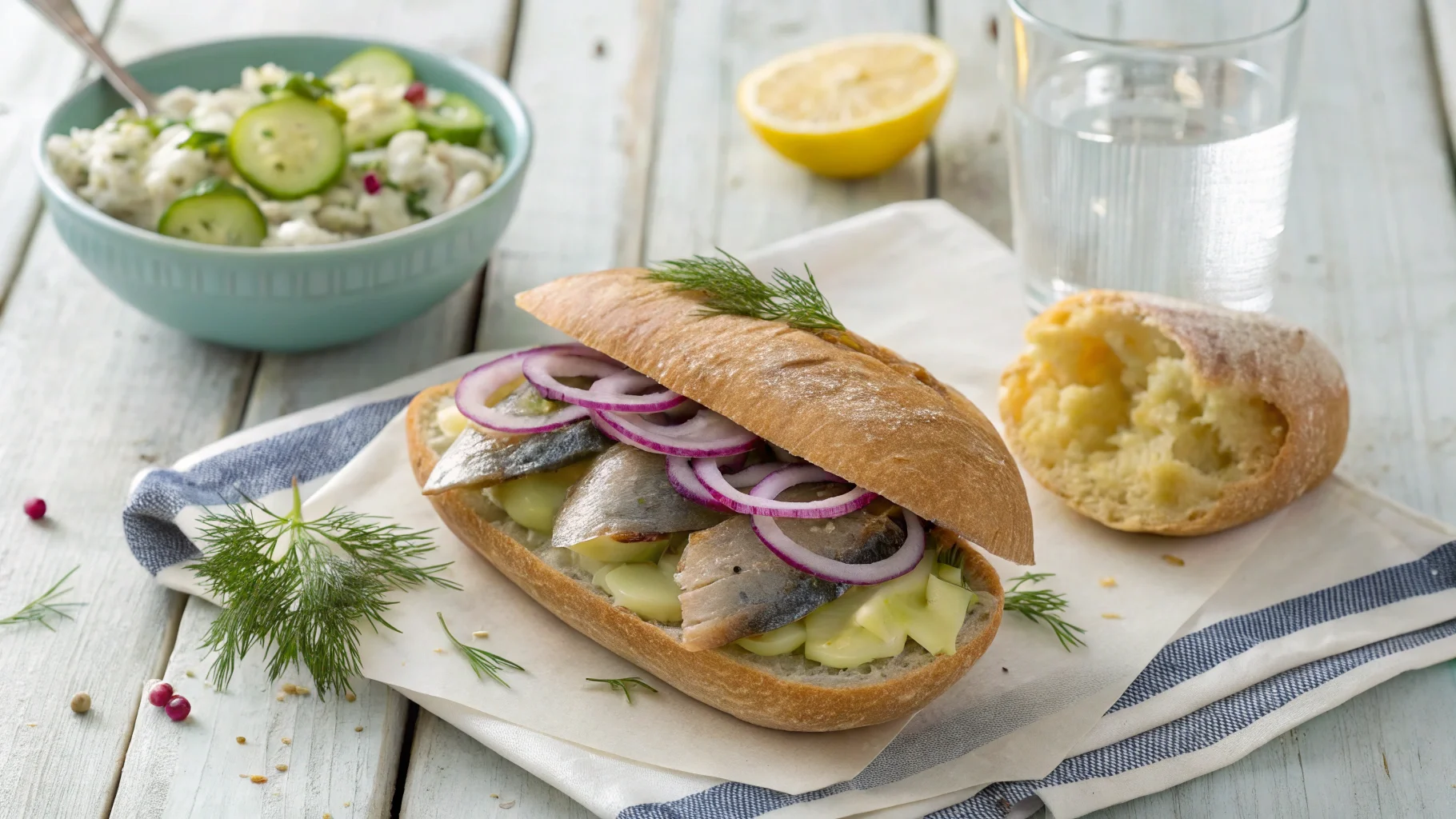Matjesbrötchen is a culinary gem from Northern Germany that perfectly combines tradition, flavor, and simplicity. This delightful herring sandwich has been a staple in coastal regions, winning hearts with its unique mix of soft bread rolls, tangy matjes herring, and vibrant toppings. In this article, we’ll explore the history of this iconic sandwich, the best ingredients, step-by-step preparation, serving tips, and creative variations that cater to every palate. Whether you’re a fan of seafood, German street food, or just looking to try something new, the Matjesbrötchen recipe is an excellent choice to savor and share. Let’s dive in!
Introduction to Matjesbrötchen recipe
What is Matjesbrötchen?
The Matjesbrötchen recipe is a traditional German sandwich that features tender, pickled matjes herring tucked into a soft bread roll, usually a Kaiser roll or another crusty option. Its toppings, like onions, dill, and mustard, add bursts of flavor and texture, making each bite irresistibly good. Originating in the northern coastal regions, this sandwich is a celebrated street food item that embodies the essence of German culinary tradition.
The Popularity of Matjesbrötchen in German Cuisine
In cities like Hamburg, Matjesbrötchen is more than just a sandwich—it’s a cultural icon. It’s served at food festivals, sold at street stalls, and cherished for its simplicity and rich flavors. This dish brings together the best of what German cuisine offers: fresh ingredients, bold flavors, and a respect for tradition. The popularity of this sandwich has even spread to neighboring countries, inspiring variations that still honor its roots.
Why You Should Try This Unique Recipe
If you love seafood and sandwiches, Matjesbrötchen is the ultimate combination. It’s healthy, thanks to the omega-3 fatty acids and protein in matjes herring, and it’s incredibly versatile. Whether you serve it as a quick lunch, a snack, or a light dinner, this sandwich is bound to impress. Plus, it’s easy to make at home with just a few fresh ingredients, making it an accessible way to enjoy a slice of German street food culture.
The History of Matjesbrötchen recipe
Origins of Matjesbrötchen recipe in Northern Germany
The Matjesbrötchen recipe has deep roots in the northern coastal regions of Germany, particularly in cities like Hamburg and Emden. Centuries ago, fishing was not just a livelihood but a way of life for these coastal communities. Matjes herring, a young, pickled version of herring, became a staple because it was easy to preserve and packed with nutrients. Combining matjes with fresh bread rolls offered a portable, satisfying meal for fishermen, sailors, and workers on the go.
Cultural Significance and Festivals
Today, Matjesbrötchen is more than just food—it’s a symbol of German culinary heritage. Every year, cities like Emden host events like the Emden Matjesfest, a festival dedicated to celebrating matjes herring. These events draw crowds from around the world, showcasing traditional recipes and innovative variations of this iconic dish. In Hamburg, the sandwich is a street food favorite, sold at bustling markets and coastal eateries.
Evolution of the Recipe Over the Years
While the classic Matjesbrötchen recipe remains beloved, it has evolved over time to include modern twists. Early versions often consisted of just herring and butter on a roll. Now, toppings like onions, dill, mustard, and pickles are popular additions, enhancing both flavor and texture. Regional variations have also emerged, incorporating sauces, vegetables, and different types of bread. Despite these changes, the dish’s essence—a celebration of fresh, simple ingredients—remains unchanged.
Key Ingredients for Authentic Matjesbrötchen
Essential Ingredients: Matjes Herring and Bread Rolls
At the heart of the Matjesbrötchen recipe lies matjes herring, a young herring cured in a mild brine of salt and sugar. This process gives the fish a tender, melt-in-your-mouth texture and a sweet yet tangy flavor. To complement the herring, crusty bread rolls, such as Kaiser rolls, are the traditional choice. Their firm exterior and soft interior provide the perfect balance to the delicate fish.
Toppings That Enhance the Flavor
The toppings are what take this sandwich from good to great. Thinly sliced red onions add a sharp crunch, while fresh dill and parsley bring a burst of herbal freshness. Pickles provide a tangy contrast, and optional spreads like mustard or creamy dill sauce lend richness. For those who love bold flavors, a sprinkle of horseradish or lemon zest can elevate the dish even further.
Tips for Choosing High-Quality Ingredients for Matjesbrötchen recipe
When preparing the Matjesbrötchen recipe, quality is everything. Look for matjes herring that’s fresh, tender, and not overly salty. Bread rolls should be freshly baked, with a soft crumb and a slightly crispy crust. For the toppings, use fresh herbs, ripe onions, and premium pickles to ensure every bite bursts with flavor. By prioritizing quality, you can create an authentic, unforgettable dish.

Preparing the Ingredients for Matjesbrötchen recipe
Prepping the Matjes Herring
The star of the Matjesbrötchen recipe is undoubtedly the matjes herring. Begin by removing the herring from its packaging and rinsing it gently under cold water to wash away any excess brine. If the fish is too salty, soaking it in cold water for about 10 minutes will tone down the saltiness. Once rinsed, pat the herring dry with a paper towel. For a uniform presentation, slice the fillets into smaller, bite-sized pieces.
Choosing and Toasting the Perfect Bread Roll
Bread plays an equally vital role in the Matjesbrötchen recipe. A fresh Kaiser roll or crusty whole-grain bread is ideal. Slice the rolls horizontally and toast them lightly to create a barrier that prevents sogginess. Toasting also adds a delightful crunch to balance the soft texture of the herring. For those preferring softer bread, skip the toasting and enjoy the natural tenderness.
Slicing and Preparing the Toppings
Toppings enhance the flavor profile of the sandwich. Slice red onions into thin rings for a sharp, crunchy texture. Finely chop dill and parsley to sprinkle as garnishes. Thinly slice pickles for a tangy twist. If using creamy sauces, prepare them in advance for smooth assembly later. By organizing ingredients beforehand, the sandwich-making process becomes quick and seamless.
Assembling the Perfect Matjesbrötchen recipe
Layering the Ingredients for Optimal Flavor
To assemble your Matjesbrötchen recipe, start with the base. Spread butter, mustard, or a creamy dill sauce evenly on the bottom half of the toasted bread roll. This layer not only adds flavor but also prevents moisture from seeping into the bread. Place the matjes herring pieces evenly over the spread, ensuring that every bite contains a satisfying portion of fish.
Adding Toppings for Texture and Presentation
Next, layer your toppings with care. Add the thinly sliced onions for crunch, followed by pickles for a tangy kick. Sprinkle fresh dill and parsley generously for an herbal aroma and a pop of color. For an optional zesty flavor, squeeze a bit of lemon juice or add a dash of horseradish. These layers not only look appealing but also enhance the sandwich’s complexity.
Final Touches to Elevate the Dish
Gently place the top half of the roll onto the sandwich, pressing lightly to hold the layers together. Be cautious if using creamy sauces to prevent overflow. Serve the Matjesbrötchen immediately to enjoy its freshest flavors. Pair it with a side of German potato salad or a crisp green salad to complete the meal.
For more delicious recipes, check out our Cucumber Salad with Smoked Salmon recipe for a refreshing side dish idea!
Serving Suggestions and Pairings
Side Dishes to Accompany Matjesbrötchen
A well-prepared Matjesbrötchen recipe shines even brighter with the right accompaniments. Traditional German potato salad, with its tangy dressing, is a classic pairing that complements the herring’s delicate flavor. For a lighter side, try a simple green salad with a light dressing. Its crisp texture and refreshing taste balance the richness of the sandwich.
If you’re in the mood for something heartier, serve your Matjesbrötchen with roasted potatoes or crispy fries. These sides add a satisfying crunch that works beautifully with the sandwich’s soft bread and tender fish.
Troubleshooting Common Problems
Preventing Soggy Bread
One of the most common challenges with the Matjesbrötchen recipe is soggy bread. To avoid this, lightly toast your bread rolls before assembling the sandwich. Toasting not only creates a protective barrier but also adds a subtle crunch. Additionally, pat the matjes herring dry with a paper towel to remove excess moisture. If using sauces, apply them sparingly and consider spreading them directly on the bread instead of the fish.
Balancing Salty and Tangy Flavors
Matjes herring is naturally salty, which can sometimes overpower the other ingredients. To achieve balance, soak the herring briefly in cold water to reduce its saltiness. For a milder flavor, soak sliced onions in water before adding them to the sandwich. Pickles or a squeeze of lemon juice can also help cut through the saltiness, offering a tangy counterbalance.
Making Adjustments for Dietary Preferences
Adapting the Matjesbrötchen recipe to suit different diets is straightforward. For a gluten-free option, use gluten-free rolls or rye bread. If you prefer a dairy-free version, skip the butter or creamy sauces, opting for mustard or a plant-based alternative instead. These adjustments ensure everyone can enjoy this delicious dish without compromise.

Creative Variations of Matjesbrötchen recipe
Scandinavian Twist: Rye Bread and Mustard Sauce
For a Nordic-inspired take on the Matjesbrötchen recipe, swap the traditional bread roll for a slice of dense, earthy rye bread. This variation pairs beautifully with the tangy herring and gives the dish a heartier feel. Instead of butter or creamy dill sauce, spread a thin layer of mustard sauce on the bread for an added kick. Garnish with fresh dill and thinly sliced cucumbers to complete the Scandinavian vibe.
Spicy Modern Versions
If you enjoy a bit of heat, give your Matjesbrötchen a modern twist by adding thinly sliced jalapeños or a drizzle of spicy aioli. These bold flavors enhance the herring’s mild tanginess without overwhelming it. Another idea is to sprinkle a dash of smoked paprika over the finished sandwich for a subtle, smoky flavor that elevates the dish.
Vegetarian and Vegan Alternatives
For a vegetarian or vegan-friendly version, replace the matjes herring with marinated tofu or roasted eggplant slices. Use plant-based spreads like vegan mayonnaise or mustard to keep the sandwich flavorful and satisfying. Adding crunchy toppings, such as shredded carrots or thinly sliced radishes, brings both texture and a pop of color to your creation.
The Matjesbrötchen recipe is incredibly versatile, so don’t hesitate to get creative with your own favorite ingredients!
FAQs About Matjesbrötchen
What Makes Matjes Special?
Matjes sandwich is young herring that’s been cured in a mild brine of sugar and spices. Unlike heavily pickled fish, matjes has a tender texture and a slightly sweet, delicate flavor. This unique preparation makes it ideal for dishes like the Matjesbrötchen recipe, as it balances perfectly with the bread and toppings.
Is Matjesbrötchen Healthy?
Yes! The Matjesbrötchen recipe is not only delicious but also nutritious. Matjes herring is packed with omega-3 fatty acids, which are great for heart and brain health. It’s also a good source of protein, Vitamin D, and B vitamins. To make it even healthier, opt for whole-grain bread rolls and fresh, unprocessed toppings.
What Does Matjesbrötchen Recipe Taste Like?
The Matjesbrötchen recipe offers a delightful combination of flavors and textures. The herring is sweet and tangy, while the bread provides a soft yet slightly crunchy base. Toppings like onions, dill, and pickles add a fresh, zesty kick, making each bite both satisfying and refreshing.
Conclusion: Embracing a German Classic
Celebrating the Tradition of Matjesbrötchen recipe
The Matjesbrötchen recipe is more than just a meal—it’s a connection to Germany’s rich coastal culinary traditions. From its origins as a humble worker’s lunch to its status as a beloved street food, this sandwich represents the best of simple, flavorful cooking. Its enduring appeal lies in its ability to bring together fresh ingredients and bold flavors, all while remaining easy to prepare.
Encouragement to Experiment with Personal Twists
One of the greatest joys of the Matjesbrötchen recipe is its versatility. Whether you stick to the classic version or try creative variations, this dish is incredibly adaptable. Experiment with new toppings, explore different bread types, or even create vegan-friendly options. Each adjustment offers a fresh take on this iconic recipe while still respecting its traditional roots.
Inviting Readers to Share Their Experiences
Now that you’ve explored every aspect of the Matjesbrötchen recipe, it’s time to roll up your sleeves and give it a try. Whether you’re enjoying it as a quick snack or serving it at a gathering, this dish is sure to impress. Don’t forget to share your creations with friends and family—they might just fall in love with this German classic, too!

